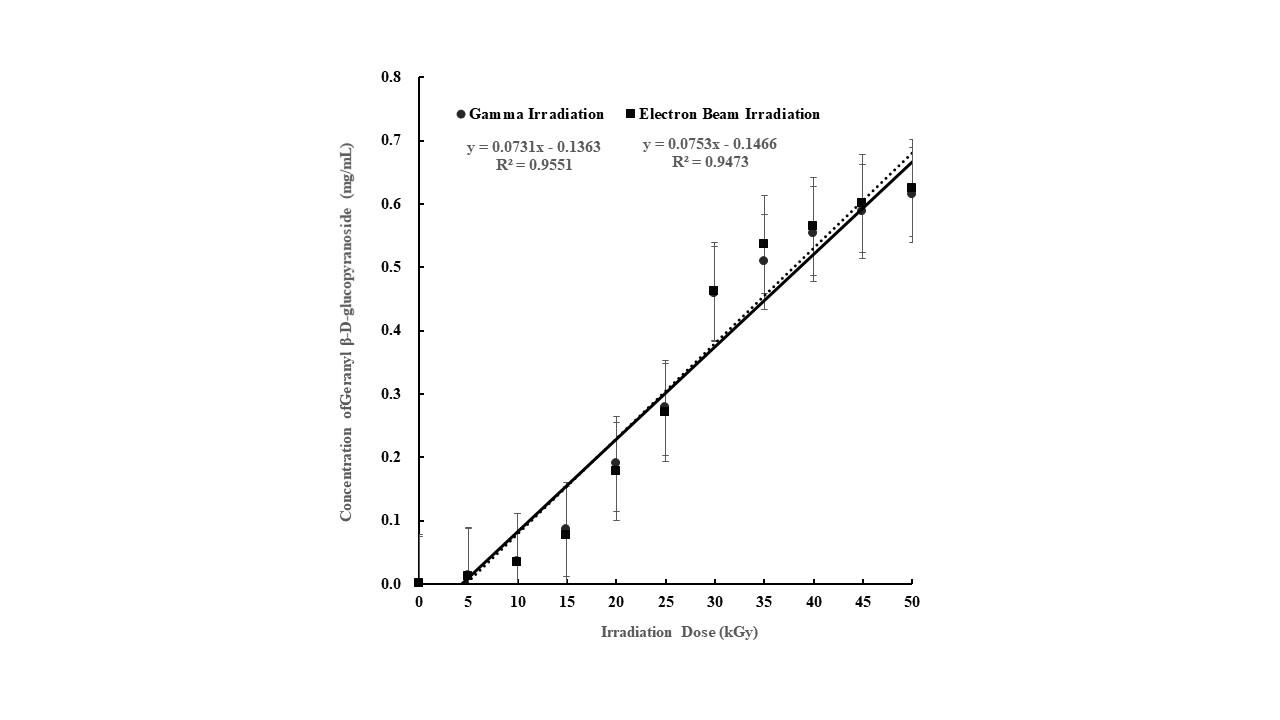Synthesis of Geranyl β-D-glucopyranoside by electron beam irradiation in aqueous condition with geraniol and glucose molecules
Ju-Woon Lee1,5, Mi-Jin Kwon2, Young Ho Cho3, Kwan-Soo Kim4, Sang-Chul Kim5, Hao Chen6, Chengbi Cui7, Youn-Miik Lim8, Byungnam Kim8.
1Headquarter, PSA CO. LTD, Pusan, Korea; 2R&D Center, PSA CO. LTD, Pusan, Korea; 3Department of Pharmacy and Biotechnology, Konyang University, Daejeon, Korea; 4Headquarter, Greenpia Technology Inc, Yeoju, Korea; 5R&D Center, Greenpia Technology Inc, Yeoju, Korea; 6Headquarter, Sichuan Institute of Atomic Energy, Chengdu, P.R. China; 7Department of Food Science and Nutrition, Yanbian University, Yanji, P.R. China; 8Radiation Utiilization and Facility Management Division, Korea Atomic Energy Research Institute, Jeongeup, Korea
OBJECTIVES
Geranyl beta-D-glucopyranoside (GG) is a natural product (Bhardwaj et al., 2018) and has various applications in bioindustry. In previous study (Xin et al., 2019), GG were higher in gamma-irradiated R. sachalinensis root extract than in non-irradiated one. This study was conducted to determine the synthesis of GG by ionizing radiation in same molecular concentrations of geraniol (GN) and glucose (GLU).
EXPERIMENTS
GN and GLU solutions of 100 μM were prepared and irradiated at absorbed doses of 5, 10, 15, 20, 25, 30, 35, 40, 45 and 50 kGy. Gamma irradiation and electron beam irradiation were performed in a cobalt-60 irradiator and using 2.5 MeV electron beam accelerator, respectively. The quantification of GG was conducted by reversed phase HPLC (Priebe et al., 2018).
RESULTS AND DISCUSSION
Figure 1 shows the concentration of GG detected in the mixed solution of GN and GLU irradiated with ionizing radiation. GG was not determined at 0 kGy. It was found that the content of GG in the mixed solution increased as the irradiation dose increased. Difference in radiation types was not found.

Figure 2 schematically shows the synthesis of GG by ionizing radiation based on each structural formula. This binding is the same binding reaction that occurs in the glucosylation reaction caused by β-glucosidase or glycosyltransferase in a biological method (Priebe et al., 2018).

The result suggests the possibility that radiation technology can be applied to the synthesis of glycosides. Many studies are still needed to put it into practical use.
REFERENCES
Bhardwaj, P., et al., 2018. New Age Herbals. Springer, Singapore. P. 71–113.
Priebe, X., et al., 2018. Enzyme Microb. Technol. 112, 79–87.
Xin, Q., et al., 2019. Molecules 24, 3981-3990.